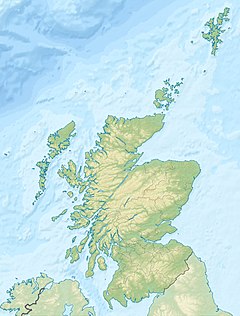North Rona
| Gaelic name | |
|---|---|
| Norse name | hraun-øy? |
| Meaning of name | possibly "seal island" |
| Location | |
|
North Rona shown within Scotland
|
|
| OS grid reference | HW811323 |
| Coordinates | 59°07′N 5°49′W / 59.12°N 5.82°W |
| Physical geography | |
| Island group | North Atlantic |
| Area | 270 acres (109 hectares) |
| Area rank | 145 |
| Highest elevation | Tobha Rònaigh 354 ft (108 metres) |
| Administration | |
| Sovereign state | United Kingdom |
| Country | Scotland |
| Council area | Comhairle nan Eilean Siar |
| Demographics | |
| Population | 0 |
| References | |

North Rona
|
|
|
Scotland
|
|
| Coordinates | 59°07′17″N 5°48′53″W / 59.121272°N 5.814784°W |
|---|---|
| Year first constructed | 1984 |
| Automated | 1984 |
| Construction | masonry building |
| Tower shape | parallelepiped building with lantern on the roof |
| Markings / pattern | white building |
| Height | 13 metres (43 ft) |
| Focal height | 114 metres (374 ft) |
| Light source | solar power |
| Characteristic | Fl (3) W 20s. |
| Admiralty number | A3869 |
| NGA number | 3574 |
| ARLHS number | SCO-153 |
| Managing agent | Rona and Sula Sgeir National Nature Reserve |
Rona (Scottish Gaelic: Rònaigh, pronounced [rˠɔːnaj]) is a remote Scottish island in the North Atlantic. Rona is often referred to as North Rona in order to distinguish it from South Rona (another small island, in the Inner Hebrides). It has an area of 109 hectares (270 acres) and a maximum elevation of 108 metres (354 ft)
The island lies 71 kilometres (44 mi) north north east of the Butt of Lewis and 18 kilometres (11 mi) east of Sula Sgeir. More isolated than St Kilda, it is the most remote island in the British Isles to have ever been inhabited on a long-term basis. It is also the closest neighbour to the Faroe Islands. Because of the island's remote location and small area, it is omitted from many maps of the United Kingdom.
The name "Rona" may come from hraun-øy, Old Norse for "rough island", a combination of ròn and øy, Gaelic and Old Norse for "seal" and "island" respectively, or it may have been named after Saint Ronan. The English language qualifier "North" is sometimes used to distinguish the island from Rona off Skye. In Gaelic it is also known as Rònaigh an Daimh which is literally "Rona of the stag" but may be derived from Rònaigh an Taibh, containing the Norse word tabh, meaning "ocean" and convey the meaning "Rona of the Atlantic".
Rona is said to have been the residence of Saint Ronan in the eighth century. A tiny early Christian oratory which may be as early as this date, built of unmortared stone, survives virtually complete on the island - the best preserved structure of this type in Scotland. A number of simple cross-slabs of early medieval date are preserved within the structure, probably the grave-markers of Dark Age monks or hermits from Scotland or Ireland. The island continued to be inhabited until the entire population of thirty died shortly after 1685 after an infestation by rats, probably the black rat (Rattus rattus), which reached the island after a shipwreck. The rats raided the food stocks of barley meal and it is possible the inhabitants starved to death, although plague may have been a contributory factor. This occurred in a year in which it is reported that no further ships reached the isolated island to supply or trade. The rats themselves eventually starved to death, the huge swells the island experiences preventing their hunting along the rocky shores.
...
Wikipedia


